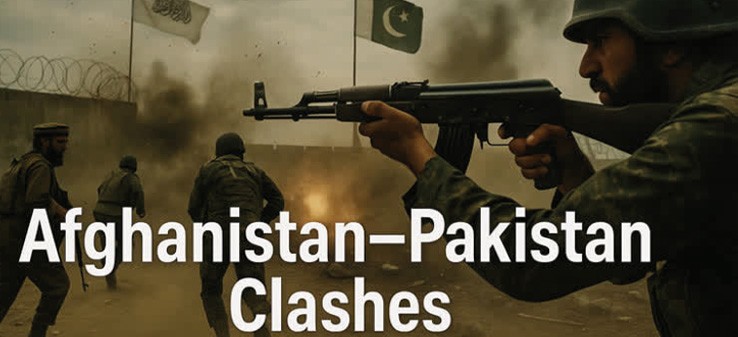The Pakistan–Taliban Conflic
The Pakistan–Taliban Conflict: Roots and Consequences
The ongoing clashes between Pakistan and Afghanistan, in terms of both intensity and scope, represent the most significant confrontation between the Taliban government and Pakistan to date. In terms of intensity, Pakistan has conducted what it describes as a “hybrid operation” against the group known as Tehrik-e-Taliban Pakistan (TTP), consisting of a wide range of aerial and ground attacks extending into Afghan territory. It has been claimed that in a Pakistani airstrike on Kabul, Noor Wali Mehsud, the leader of the TTP, and several others were killed. In response, the Afghan Taliban have carried out extensive operations against Pakistani border outposts in at least seven provinces bordering Pakistan. Although the reported number of casualties varies, it is certain that dozens of people on both sides have been killed in these clashes.
By: Nozar Shafiei
11 Minutes Reading
11 Minutes Reading
|
What You Read in This Report 1. Introduction 2. Causes and Roots of the Conflict 3. Implications for the Region and the Islamic Republic of Iran 4. Conclusion |
Introduction
There are two main interpretations regarding the TTP’s territorial objectives.
The ongoing clashes between Pakistan and Afghanistan, in terms of both intensity and scope, represent the most significant confrontation between the Taliban government and Pakistan to date. In terms of intensity, Pakistan has conducted what it describes as a “hybrid operation” against the group known as Tehrik-e-Taliban Pakistan (TTP), consisting of a wide range of aerial and ground attacks extending into Afghan territory. It has been claimed that in a Pakistani airstrike on Kabul, Noor Wali Mehsud, the leader of the TTP, and several others were killed. In response, the Afghan Taliban have carried out extensive operations against Pakistani border outposts in at least seven provinces bordering Pakistan. Although the reported number of casualties varies, it is certain that dozens of people on both sides have been killed in these clashes.
Khawaja Asif, Pakistan’s Minister of Defense, warned in a post on X that If terrorist elements enter Pakistan from Afghan soil and shed blood, Pakistan will enter Afghan soil in accordance with its legitimate right to self-defense. He added that, to this day, Pakistan has received no guarantee from the Taliban that Afghan soil will not be used against Pakistan. Mohammad Naeem Wardak, the Taliban’s Deputy Minister of Finance, also reacted to the border attacks in a post on X, warning that Pakistani officials must respect Afghanistan’s territorial integrity and not test the patience of the Afghan people. He added that Afghanistan has multiple options to respond to Pakistan, and if these options are used, Pakistani officials will regret their actions.
Four main causes and roots can be identified in the current conflict between Pakistan and
Afghanistan:
Afghanistan:
1.1 The Issue of TTP
Pakistan claims that the Taliban government has provided safe haven in Afghanistan to the TTP, which is fighting against Islamabad. The TTP movement, estimated to have between 30,000 and 50,000 fighters, is a broad organization composed of Pakistani Pashtun Islamist militants based in Pakistan’s northwestern Federally Administered Tribal Areas along the Afghan border. The movement was founded in 2007 by Baitullah Mehsud, with its headquarters in eastern Afghanistan. It is characterized by Islamic extremism (a rigid interpretation of Sharia), Pashtun nationalism, Pashtunwali (traditional Pashtun code), and sectarianism (Deobandi orientation). These traits also describe the Afghan Taliban, which is why they are often referred to as “two bodies with one soul.” During the Afghan Taliban’s campaign against the U.S. and the central government in Kabul, the TTP consistently hosted and supported them; now the relationship appears to have reversed, with the Afghan Taliban hosting the TTP.
There are two main interpretations regarding the TTP’s territorial objectives.
The first is a narrow interpretation with a separatist nature, which asserts that the TTP’s declared goal is to eliminate Islamabad’s influence over the Federally Administered Tribal Areas and Khyber Pakhtunkhwa Province and to impose its strict interpretation of Sharia law in these regions. The second is a broader interpretation with totalitarian tendencies, claiming that the TTP aims to overthrow the government in Islamabad and establish its ideology throughout Pakistan under the banner of an Islamic Emirate of Pakistan — mirroring what occurred in Afghanistan.
In addition to its links with the Afghan Taliban, the TTP maintains close relations with al-Qaeda. On July 29, 2011, under paragraphs 4 and 5 of Resolution 1989 (2011), the group was listed among entities associated with al-Qaeda for participating in the financing, planning, facilitating, preparing, or perpetrating acts or activities in association with, under the name of, on behalf of, or in support of al-Qaeda, as well as for supplying, selling, or transferring arms and related materials to, recruiting for, or otherwise supporting the acts or activities of al-Qaeda.
Since 2008, the TTP has repeatedly and publicly threatened to attack U.S. soil. Its spokesperson claimed responsibility for the failed car bombing in New York’s Times Square on May 1, 2010. In June 2011, a TTP spokesman vowed to avenge the death of Osama bin Laden by attacking the United States and Europe. In April 2012, one of the group’s leaders confirmed its foreign operations and threatened to conduct attacks in the United Kingdom for its involvement in Afghanistan.
1.2 Damage to Pakistan’s National Pride
Over the past two years, Pakistan has undertaken major actions that have led to a sense of national pride in the country. The most notable was its successful defense against India’s attacks three months ago. This success enhanced the standing of Pakistan’s military — whose reputation had been waning — and elevated Islamabad’s strategic credibility regionally and globally. However, Pakistan has remained vulnerable to TTP attacks, undermining its strategic image and the military’s prestige. To restore its prestige, Islamabad has taken serious military action, as well as a symbolic action by attacking Kabul and attempting to kill Mehsud, the leader of the TTP.
1.3 Close Relations Between India and the Taliban Government
Since 1947, India and Pakistan have shared one of the world’s most heavily militarized borders and have fought two major wars and several intense skirmishes, primarily over Kashmir. Pakistan has long viewed Afghanistan as a strategic rear base and hoped that the rise of the Taliban would strengthen this strategic depth. However, recent developments — particularly the TTP issue — have strained Pakistan–Taliban relations, and it now appears that the Taliban have effectively aligned themselves with India.
The clearest sign of this was the joint statement issued in New Delhi by the foreign ministers of India and Afghanistan. The statement reaffirmed the long-standing friendship and deep cultural and historical ties between the two nations; condemned the terrorist attack in Pahalgam, Jammu and Kashmir, on April 22, 2025; and reiterated Afghanistan’s commitment not to allow any group or individual to use Afghan soil against India. This statement angered Pakistani officials and was interpreted as evidence of a deepening bond between the Taliban (Pakistan’s former ally) and India (Pakistan’s long-time rival).
1.4 The Historical Dispute Over the Durand Line
The Durand Line is an international border stretching 2,640 kilometers (1,640 miles) between Afghanistan and Pakistan, running from Iran in the west to China in the east. It was established in 1893 as the boundary between the Emirate of Afghanistan and British India by Mortimer Durand, a British diplomat in the Indian Civil Service, and Abdur Rahman Khan, the Emir of Afghanistan.
After the partition of British India into India and Pakistan, the Afghan government claimed that the Durand Line had been merely a provisional and informal demarcation separating Afghanistan from British India and that, after partition, it should also be revised — effectively moving Afghanistan’s borders to what is now Pakistan’s Baluchistan and Khyber Pakhtunkhwa provinces. Consequently, while Pakistan recognizes it as an official border, successive Afghan governments have never formally done so.
This historic disagreement has evolved into a geopolitical dispute, fueling numerous conflicts between the two countries. Pakistan had hoped that supporting the Taliban and fostering an Islamic government in Afghanistan would reduce nationalist approaches to the Durand Line. However, when Pakistan began constructing a border fence along the line two years ago, the Taliban reacted strongly — an episode that paved the way for the rift between these former allies.
To assess the regional consequences of the Pakistan–Taliban conflict and its implications for the Islamic Republic of Iran, two scenarios must be considered:
⦁ First Scenario: If “the current conflict is managed through third-party mediation and escalation is prevented,” Iran can also contribute to crisis resolution and stabilization of a ceasefire through regional cooperation, and thereby enhancing its regional credibility.
⦁ Second Scenario: If “the current conflict escalates into a full-scale war,” then Iran, consistent with its historical role in the region, must actively pursue good offices diplomacy to help resolve the dispute and encourage both sides to exercise restraint.
In general, the following points regarding the regional effects of the ongoing Pakistan–Afghanistan conflict and its implications for Iran deserve attention:
⦁ The conflict between Pakistan and Afghanistan is occurring within a region of which Iran is a part. According to general systems theory, instability in one part of a system affects all its components.
⦁ These conflicts contribute to the rise of extremism and separatism, both of which impact Iran’s eastern borders.
⦁ The clashes will exacerbate migration and refugee crises, spilling instability into Afghanistan’s neighboring countries. This in turn brings additional security challenges such as terrorism, infiltration, and organized crime (including drug trafficking, human trafficking, arms smuggling, and border violence) that threaten both the region and Iran.
⦁ The current tensions will likely improve the Taliban government’s relations with India, thereby reshaping the broader security dynamics of South Asia.
The outcome of the current situation is the transformation of regional equations from linear to complex and multidimensional. In the previous linear framework, Pakistan and the Taliban were aligned, and to some extent, against India. Now, the equation has reversed. In this new configuration, the nature of the Taliban’s relations with China, Russia, the United States, and Iran may all be affected.
For example, given the U.S. and India’s ongoing rivalry with China, there is a possibility that Washington could re-enter Afghanistan through India. Another possibility is that, given the closeness between Moscow and New Delhi as well as the Taliban's closeness to China, Russia, and Iran, India might pursue a strategy of “strategic autonomy,” focusing only on deepening its relations with the Taliban government and exerting influence on Pakistan.
In any case, under current circumstances, the regional security landscape has become increasingly opaque, significantly narrowing the vision and predictive capacity of policymakers regarding future political and security developments.
Nozar Shafiei is a South Asia Expert.
News code:4155















